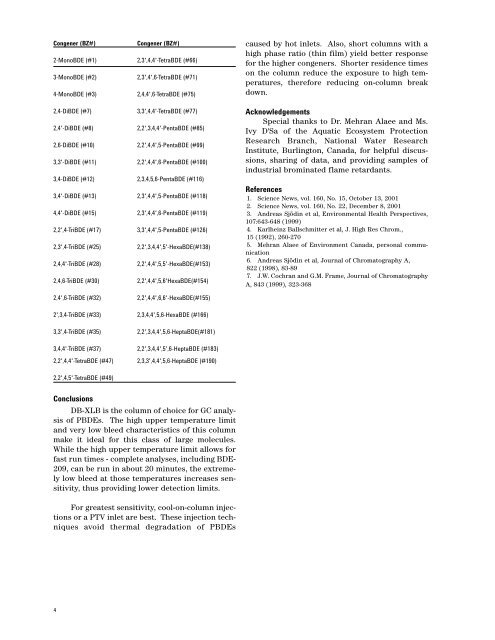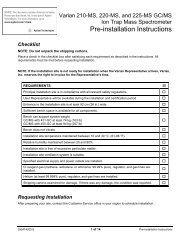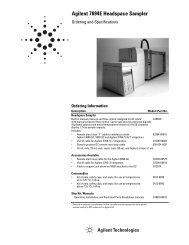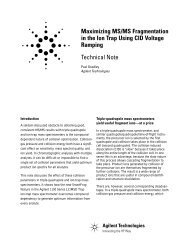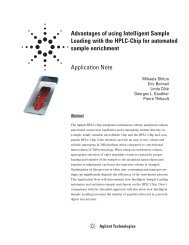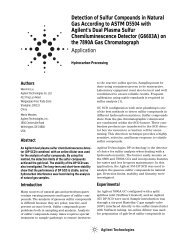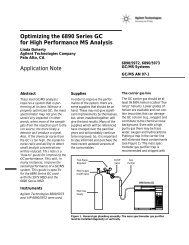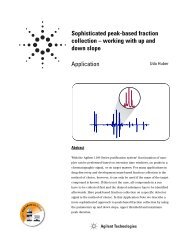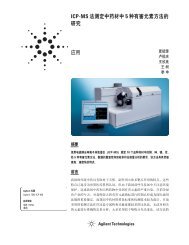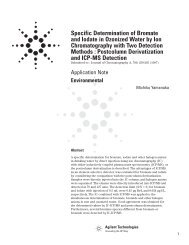GC/MS Analysis of Polybrominated Flame Retardants - Agilent ...
GC/MS Analysis of Polybrominated Flame Retardants - Agilent ...
GC/MS Analysis of Polybrominated Flame Retardants - Agilent ...
Create successful ePaper yourself
Turn your PDF publications into a flip-book with our unique Google optimized e-Paper software.
Congener (BZ#)<br />
Congener (BZ#)<br />
2-MonoBDE (#1) 2,3',4,4'-TetraBDE (#66)<br />
3-MonoBDE (#2) 2,3',4',6-TetraBDE (#71)<br />
4-MonoBDE (#3) 2,4,4',6-TetraBDE (#75)<br />
2,4-DiBDE (#7) 3,3',4,4'-TetraBDE (#77)<br />
2,4'-DiBDE (#8) 2,2',3,4,4'-PentaBDE (#85)<br />
2,6-DiBDE (#10) 2,2',4,4',5-PentaBDE (#99)<br />
3,3'-DiBDE (#11) 2,2',4,4',6-PentaBDE (#100)<br />
3,4-DiBDE (#12) 2,3,4,5,6-PentaBDE (#116)<br />
3,4'-DiBDE (#13) 2,3',4,4',5-PentaBDE (#118)<br />
4,4'-DiBDE (#15) 2,3',4,4',6-PentaBDE (#119)<br />
2,2',4-TriBDE (#17) 3,3',4,4',5-PentaBDE (#126)<br />
2,3',4-TriBDE (#25)<br />
2,2',3,4,4',5'-HexaBDE(#138)<br />
2,4,4'-TriBDE (#28)<br />
2,2',4,4',5,5'-HexaBDE(#153)<br />
2,4,6-TriBDE (#30)<br />
2,2',4,4',5,6'HexaBDE(#154)<br />
caused by hot inlets. Also, short columns with a<br />
high phase ratio (thin film) yield better response<br />
for the higher congeners. Shorter residence times<br />
on the column reduce the exposure to high temperatures,<br />
therefore reducing on-column break<br />
down.<br />
Acknowledgements<br />
Special thanks to Dr. Mehran Alaee and Ms.<br />
Ivy D'Sa <strong>of</strong> the Aquatic Ecosystem Protection<br />
Research Branch, National Water Research<br />
Institute, Burlington, Canada, for helpful discussions,<br />
sharing <strong>of</strong> data, and providing samples <strong>of</strong><br />
industrial brominated flame retardants.<br />
References<br />
1. Science News, vol. 160, No. 15, October 13, 2001<br />
2. Science News, vol. 160, No. 22, December 8, 2001<br />
3. Andreas Sjödin et al, Environmental Health Perspectives,<br />
107:643-648 (1999)<br />
4. Karlheinz Ballschmitter et al, J. High Res Chrom.,<br />
15 (1992), 260-270<br />
5. Mehran Alaee <strong>of</strong> Environment Canada, personal communication<br />
6. Andreas Sjödin et al, Journal <strong>of</strong> Chromatography A,<br />
822 (1998), 83-89<br />
7. J.W. Cochran and G.M. Frame, Journal <strong>of</strong> Chromatography<br />
A, 843 (1999), 323-368<br />
2,4',6-TriBDE (#32)<br />
2,2',4,4',6,6'-HexaBDE(#155)<br />
2',3,4-TriBDE (#33) 2,3,4,4',5,6-HexaBDE (#166)<br />
3,3',4-TriBDE (#35)<br />
2,2',3,4,4',5,6-HeptaBDE(#181)<br />
3,4,4'-TriBDE (#37) 2,2',3,4,4',5',6-HeptaBDE (#183)<br />
2,2',4,4'-TetraBDE (#47) 2,3,3',4,4',5,6-HeptaBDE (#190)<br />
2,2',4,5'-TetraBDE (#49)<br />
Conclusions<br />
DB-XLB is the column <strong>of</strong> choice for <strong>GC</strong> analysis<br />
<strong>of</strong> PBDEs. The high upper temperature limit<br />
and very low bleed characteristics <strong>of</strong> this column<br />
make it ideal for this class <strong>of</strong> large molecules.<br />
While the high upper temperature limit allows for<br />
fast run times - complete analyses, including BDE-<br />
209, can be run in about 20 minutes, the extremely<br />
low bleed at those temperatures increases sensitivity,<br />
thus providing lower detection limits.<br />
For greatest sensitivity, cool-on-column injections<br />
or a PTV inlet are best. These injection techniques<br />
avoid thermal degradation <strong>of</strong> PBDEs<br />
4


